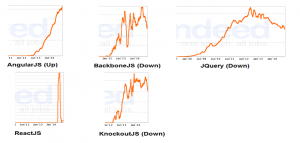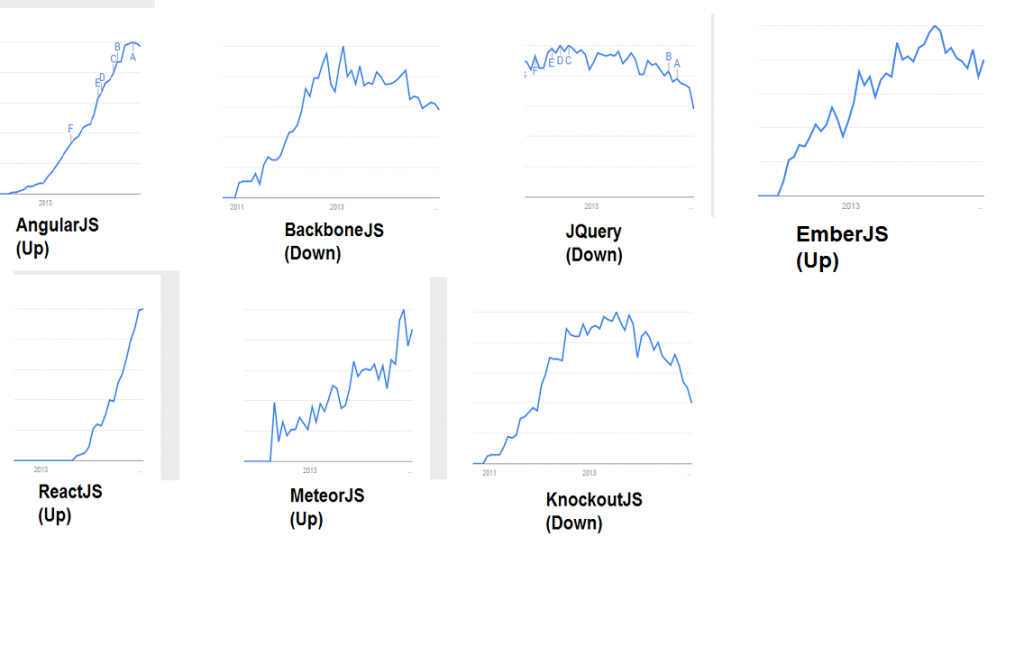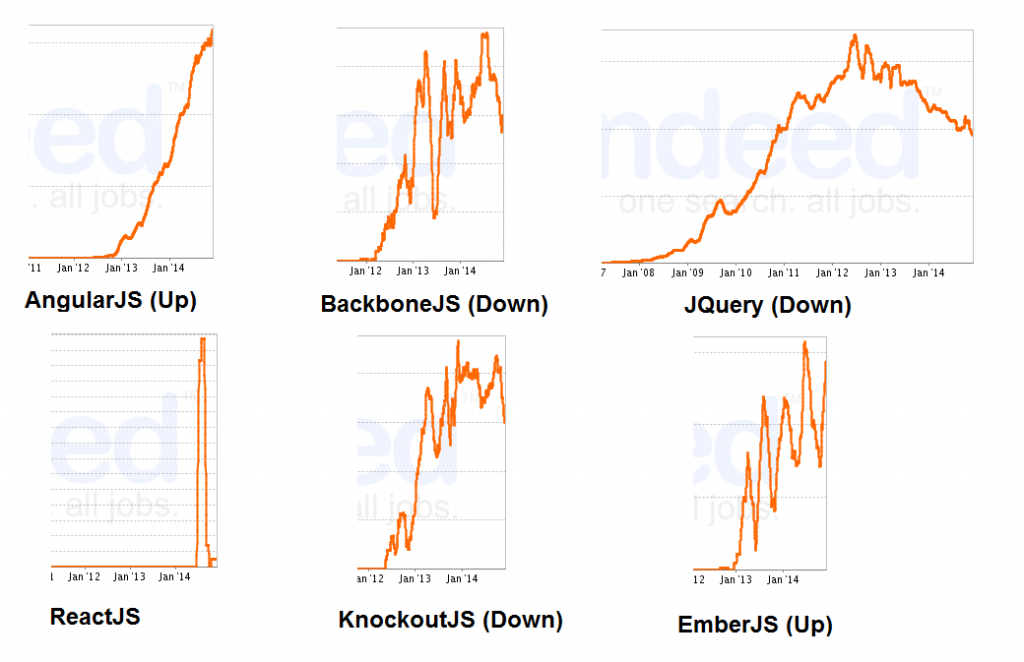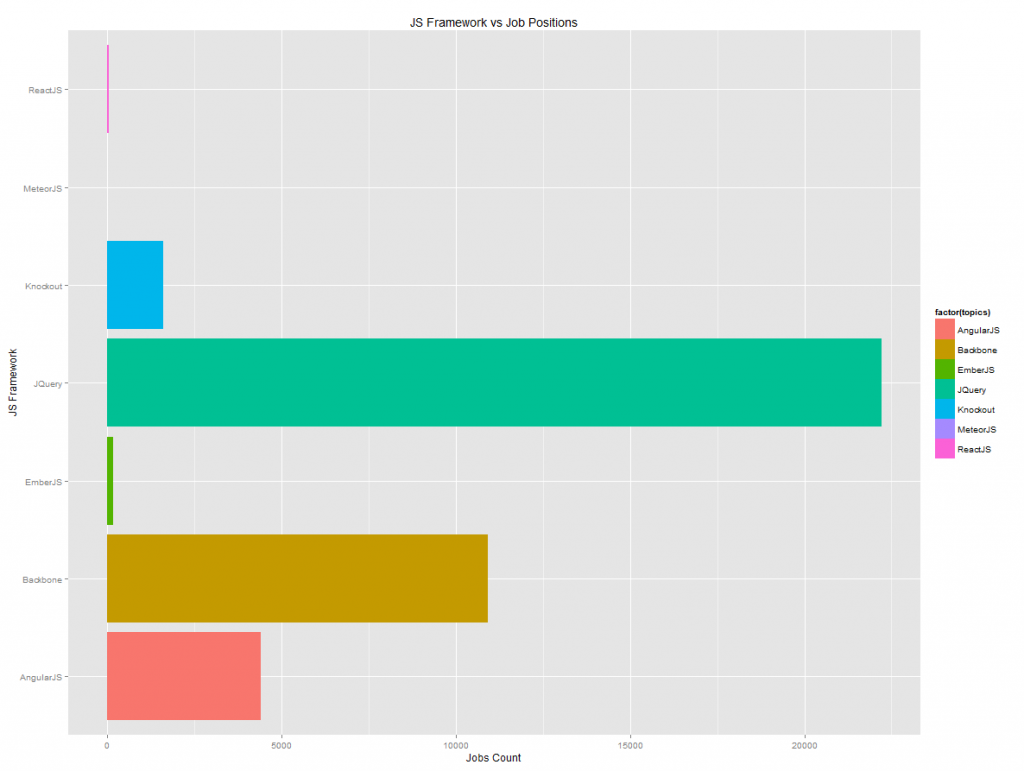
- AngularJS
- JQuery
- BackboneJS
- KnockoutJS
- ReactJS
- MeteorJS
- EmberJS
The analytics presents data based on trends captured from Google Trends and Indeed.com job trends. Please feel free to suggest any javascript frameworks that I may have missed. From the analysis below, following are top 4 javascript frameworks that you may want to watch out in 2015:
- AngularJS
- ReactJS
- MeteorJS
- EmberJS
Updated the blog with an entry of EmberJS based on the suggestion of one of the readers. Please feel free to suggest others.
Google Trends for Javascript Frameworks
Following image represents search trends on above-mentioned JS frameworks, being captured from google.com trends website.
Based on the image, one could infer that following are top 4 Javascript frameworks that are searched most at this point of time in year 2015.
- AngularJS
- ReactJS
- MeteorJS: Important thing about MeteorJS is that it does not yet support windows version and still is showing upward trend.
- EmberJS
The above framework however shows up like following (in order) based on search done and hence, popularity in US.
- ReactJS & MetoerJS
- EmberJS
- AngularJS: Interestingly, AngularJS is searched most by developers out of India.
It is also interesting to observe that following three frameworks have been declining in its popularity from the perspective of search happening at this time in comparison with starting of 2014.
- JQuery
- Backbone
- Knockout
Indeed.com (Job) Trends for Javascript Frameworks
Following image represents job trends on above-mentioned JS frameworks, being captured from indeed.com trends website.
From the above image, one could infer that Job positions for AngularJS is rising and, for following three frameworks is declining:
- JQuery
- Backbone
- Knockout
JQuery is not going to go soon anywhere. However, it will certainly be interesting to watch how it shows up in near future in term of adoption.
Following represents the number of job positions consisting of keywords related with above JS frameworks. It represents the fact that still JQuery rules, but also indicates that AngularJS is catching up.
- Coefficient of Variation in Regression Modelling: Example - November 9, 2025
- Chunking Strategies for RAG with Examples - November 2, 2025
- RAG Pipeline: 6 Steps for Creating Naive RAG App - November 1, 2025



Are all y scales in trend plots the same? Thanks for your updates!
Hi, I really like AngularJS but those graphs are pretty useless:
It’s quite funny that you cropped axis y for graphs. For example indeed.com graphs:
– jquery had 800,000+ jobs in peak and about 500,000 now
– angularjs has 50,000 jobs now
– emberjs – 10,000+
– backbone – 10,000+
So
1) the difference between all the frameworks except jquery is not that big compare with jquery itself and draw trends for them is almost useless
2) even if we would assume that current trends will be the same for all the frameworks (honestly I don’t think so), anyway it would be easier to find a job for jQuery developer at least for next five years
Combined Google trends looks almost the same: a lot of jquery with negative trend of course but others almost not exist (angularjs by the way has there almost no growth for the last 6 months): http://www.google.com.au/trends/explore#q=angularjs%2C%20jquery%2C%20backbonejs%2C%20Emberjs&date=1%2F2010%2060m&cmpt=q&tz=
Thanks for your comments, Alex. The plots are just meant to showcase the trends based on google search and job positions. These are not meant to represent facts like which framework would secure you a job or so. The objective is to inform JS developers about emerging JS frameworks and the fact the frameworks are worth a shot.